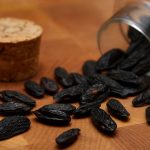It’s a strange and wonderful tree, the mulberry, and not to be overlooked the next time you’re thinking about investing in a new hardwood floor.
***
You know I’m going to talk about monkeys and weasels, right?
That’s how most of us know what the mulberry is, from that earworm of a children’s song, Pop! Goes the Weasel. I don’t know about you, but in my mind the mulberry bush wasn’t much bigger than the monkey or the weasel that were chasing each other around its trunk. It was a tiny little fruit-bearing thing in my mind, hardly big enough to make a chair from its wood, let alone a whole floor or wall.
Clearly, my childhood imagination was misinformed. The mulberry may be a fruit-bearing plant, but it’s not a bush. It can grow up to 50 feet tall in its native Southeastern United States, and it is also found as far afield as Central America, China, Japan, Libya, and Iran.
The mulberry may, in fact, be one of the most mysterious and diversely-used trees that I’ve investigated in this series. It’s responsible for not only strangely-themed nursery rhymes and delicious red, white, or dark blue berries, but mulberry trees are also integral to medical science as well as to the production of silk. It’s also used as a hallucinogen in some areas of the world. On top of all of that, mulberrywood is an excellent material for hardwood floors.
In this article, we’ll explore just how much mulberrywood has to offer, and we’ll delve into exactly why it’s just as beneficial to your home improvement as it is to hyperactive monkeys and weasels.
Mulberrywood stats
Latin name: Morus alba, nigra, rubra, etc.
Janka Hardness rating: 1680
Common color spectrum: Golden to dark reddish-brown as it ages
Stability: Very durable
All about the mulberry bush
Let’s start with those red, white, and dark blue berries. The color of the berry depends, of course, on the species of mulberry we’re talking about, but they have similar properties. Mulberries are known for their bursting flavor, which has been likened to the experience of having the feeling of fireworks in the mouth. This intensity not only makes mulberries a great option for pies and jams, but it also reflects the fact that they are filled with highly nutritional anthocyanins. Nutritional supplements and medical ingredients such as resveratrol are derived from these plants, as are natural food colors which are used not only in food production, but are vital for medical test stains.
The leaves of the mulberry are also important to a global industry; they are the only food of silkworms, the hard-working Bombyx mori. Silk production therefore relies heavily on the cultivation and protection of mulberry trees around the world. Because of this, the tree has been cultivated in many different areas of the world in the hopes that it will support additional silk industry development.
Mulberry’s new adventure
We’ve only just started to explore mulberrywood as an option for lumber, including its use as a hardwood floor component. Like other fast-growing deciduous trees, mulberry has been identified as an easily-sustainable and wide-reaching option for new plantations. Because mulberry grows in many different areas of the world, and the whole tree can be harvested and used for many different industries and applications, production can be highly profitable but also environmentally friendly.
The great thing is that mulberry works really well as a hardwood floor, with a high interior design look and feel. It has a smooth surface, a delicate grain, and its color range is exceptional. It looks beautiful in both modern and traditional interiors, and it is one of the world’s most sustainable and highly durable options for hardwood, which means that you can feel confident in your purchase of this product.
Not just the status quo
Mulberrywood takes on so many varying and important roles in our world that it is surprising that it operates so far under the radar. But, given its impact, it’s no wonder that the mulberry has reached the status of nursery rhyme feature. (It’s not only referred to in Pop! Goes the Weasel, but, of course, it also occupies a title character in Here We Go Round the Mulberry Bush.) There is much more to the mulberry than meets the eye.
It’s a strange and wonderful tree, the mulberry, and not to be overlooked the next time you’re thinking about investing in a new hardwood floor. Try mulberrywood for your next home improvement project; unlike the weasel, you won’t be running scared.

























